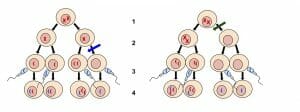Monosomy Definition
Monosomy is an example of aneuploidy, which is an imbalance in chromosome numbers. This means that we can either find extra or missing chromosomes in the cells as a result of mistakes that occur during cell division. In a monosomy, one chromosome of a homologous pair is missing. In the case of human beings, we normally have two copies of each chromosomes; one from each parent, resulting in 46 total chromosomes found in the nucleus of cells. When one pair has a missing chromosome, the resulting number becomes 45 chromosomes instead of 46, which leads to abnormalities. Keep in mind that monosomy is very rare in humans since in most cases the embryos lacking a chromosome die. Interestingly, many instances of monosomy have only part of the chromosome missing, like in cri du chat syndrome.
Types of Monosomies
Complete Monosomy
Meiosis is a process that results in four reproductive cells (eggs or sperm), each ready for fertilization and containing half the number of chromosomes found in a normal cell. Complete monosomy comes about due to unsuccessful separation of a pair of chromosomes during the process of meiosis, called nondisjunction. Once a cell that has an extra or a missing chromosome goes through fertilization, the embryo will then have an incorrect number of chromosomes. The diagram below shows how this can happen, and for simplicity purposes only one pair of chromosomes is shown at the start of meiosis. In the diagram on the left hand side, the sister chromatids don’t separate during meiosis II as they should, leading to an abnormal number of cells in two of the resulting eggs. On the other hand, the fault occurs in the first division, meiosis I, in the diagram on the right hand side. The homologous pair fails to separate at this stage, leading to the eggs either having three or a single chromosome, instead of two. As shown, in the case of the diagram on the left, where unsuccessful separation happens in a later step, there are eggs that are normal, which leads to embryos with a normal number of chromosomes after fertilization. Therefore, it is not as detrimental as the other case since it allows for the possibility of a normal human being forming. Note that complete monosomy is not inherited.

Partial Monosomy
A partial monosomy is where only some of the chromosome is missing. This can either happen when a portion of the chromosome is deleted in meiosis or at some point during the early stages of the development of the embryo. Like complete monosomy, this case of partial monosomy can’t be inherited. On the other hand, partial monosomy caused by translocation is often inherited from the parents.
Translocation is a type of mutation where a section is detached from a chromosome and joined to a different, nonhomologous chromosome. This means that the first chromosome has lost important genetic information. When this occurs in people, they will still have the genetic information within their cells and so usually have no abnormalities. However, if they are to have offspring, then there is a possibility of them passing on a chromosome that has missing information, leading to a partial monosomy. Of course, the parent can also pass on the chromosome carrying the extra information, and that would then lead to a partial trisomy. Trisomy is the presence of a third, extra copy of a chromosome, like in the case of Down’s syndrome. Therefore, partial monosomy refers to an extra copy of part of a chromosome.
Example of Monosomy
Turner’s Syndrome
Also called monosomy X, it is a genetic disorder where an individual ends up with only one X chromosome and nothing else in their final pair of chromosomes. Remember that females have two X chromosomes as their sex chromosomes, and males have an X and a Y. Therefore, individuals with Turner’s syndrome happen to be females with only one X chromosome. Having only one chromosome from the pair, these females do not develop the same way as the average female, but rather display some physical and hormonal abnormalities. All girls with Turner’s syndrome are infertile, but some have more symptoms than others. For example, they may not undergo puberty, develop breasts, or have a menstrual cycle. Also, nearly all girls are shorter than average, and often have wide necks or puffy hands and feet. Other problems can occur, too, including hearing or heart problems.
Turner’s syndrome occurs in about 1 in every 2,500 girls that are born and is not inherited from parents. Interestingly, Turner’s Syndrome is the only case of monosomy that someone can live out their life with, though most fetuses with this syndrome die before birth. Nowadays, treatments like hormone therapy help girls with this disorder live healthy lives.
Related Biology Terms
- Down’s syndrome – A genetic disorder characterized by mental retardation and caused by trisomy 21.
- Mitosis – The division of the nucleus that leads to two identical daughter cells in living organisms.
- Mosaicism – Cells within the same organism having different genetic information.
- Polyploidy – The presence of more than two sets of each chromosome in the cell.
Quiz
1. Which of the following is the cause of complete monosomy?
A. Partial deletions
B. Partial monosomy
C. Translocations
D. Nondisjunction
2. What do most monosomies lead to in humans?
A. Small feet
B. Death
C. Most aren’t dangerous and lead to no problems
D. Infertility
3. In humans, Turner’s and Down’s syndromes are examples of:
A. Monosomy
B. A monsomy and a trisomy, respectively
C. A trisomy and a monosomy, respectively
D. An aneuploidy and a monosomy, respectively
4. Which of the following is not a symptom of Turner’s syndrome?
A. Infertility
B. Short stature
C. Swollen ears
D. Swollen hands and feet
